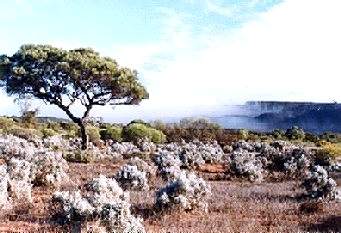 About the Town of Iron Knob
About the Town of Iron Knob 
 About the Town of Iron Knob
About the Town of Iron Knob 
The most important thing about the town of Iron Knob is that it is the birthplace of the Australian steel industry. It was here that the extremely high-grade haematite iron ore - after which this town was named - was first discovered and mined in this country. Iron Knob is situated on the Eyre Peninsula (named after the explorer Edward John Eyre) in the state of South Australia.
It lies 55 kilometres northeast of Whyalla (which in turn is currently the third largest city in South Australia, after Adelaide and Mount Gambier).
Iron Knob itself is a historically important part of what is known as the 'Iron Triangle' region, which includes the cities of Port Augusta, Port Pirie and Whyalla - so named because of their involvement with the processing and shipping of iron ore, most of which comes from the mines of the Middleback ranges. The town of Iron Knob is situated at the foot of the first of these established.
 |  |
The landscape around the town is mostly semi arid scrubland and plains. The climate has hot dry summers and cool winters with intermittent rainfall, though occasionally flooding downpours may occur in summer. Temperatures have been known to range from over 40 degrees Celcius during summer heatwaves, to below zero (at night) during winter cold snaps. Currently Iron Knob boasts a post office/tourist information centre, plus a number of small businesses including a general store/take away, bowls, golf & dart clubs, a rural transaction centre, Knobbie's Park (with public toilet and playground) a church, a cemetery, a CFS fire station, as well as the Errappa blue-light camp. As well, there are a number of unique murals and mining monuments that can be seen by visitors who wish to have a look around.
The haematite for which the mine was started is not hard to miss; any of the smooth, almost black rocks and stones scattered about the town and environs will almost always be iron ore. Some can be so metal-rich that, if chipped, may resemble rock-shaped chunks of steel beneath their weather-blackened surfaces (Iron ore does not rust in the way that metallic iron does). Haematite is not the only mineral of interest to be found at the site; the area has one of the greatest varieties of mineral types (in a single area) in Australia; some unique to the location. There is an extensive mineral collection on display at the Iron Knob Tourist Centre where some of these can be seen. Because the town is in an area that is natural scrub and grazing land, native wildlife such as kangaroos and emus may often wander into the town. Sometimes these will include male emus tending chicks; if one does encounter such a family group, it is advisable to treat them with respect as emu fathers will be highly protective of their offspring. Other wildlife include bird species such as eagles and cockatoos - as well as reptiles such as lizards and snakes. The reptiles are mainly active in the warmer months of the year (September to April), hibernating in the cooler months of May to August when the nights become too cold for them to be active. Processional caterpillars migrating in long rows after years of good rains are an interesting member of the local insect wildlife.
Most of the livestock raised in the region are merino sheep, although some properties may also keep cattle. There are also several species of feral animal existing in the area - mainly foxes, cats and goats, all of which have presented problems to both the local wildlife and the graziers, in terms of grazing competition and over-predation.
As for its human residents, the town has a population of 230 - 250 and is situated on a main highway (National Highway 1). The nearest city council is in Whyalla, but the town itself is run independently by the Iron Knob Progress Association inc., comprised of volunteer town residents who hold an interest in the town's administration, welfare and future.

wandering the main street
caterpillars
Back to Home Page
Top of Page
 |  |  |
 |  |